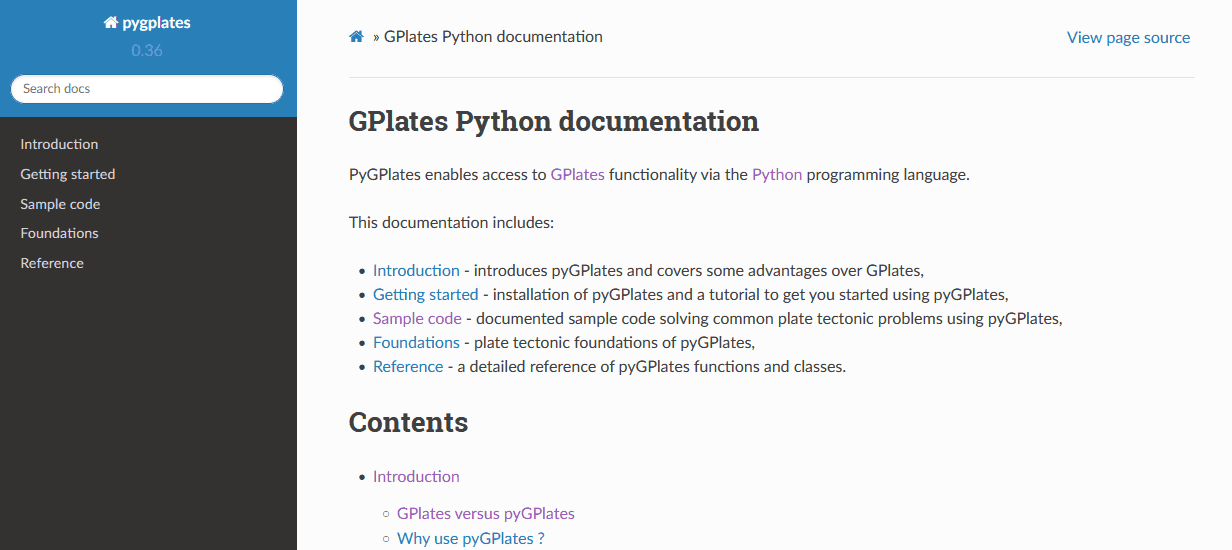PyGPlates 0.36 released
PyGPlates enables access to GPlates functionality via the Python programming language.
Download PyGPlates 0.36:-
Download PyGPlates 0.36 from the Download page.
What's new in PyGPlates 0.36:-
- Versioning scheme changed:
- This release is version 0.36 (instead of revision 36).
- Separate binary packages for macOS on Intel (x84_64) and macOS on M1 (arm64).
- Unlike GPlates, pyGPlates typically needs to be compiled separately for these two architectures.
- New class topological model:
- Use it to create a topological snapshot for a particular geological time.
- Then query snapshot for resolved topological plates and deforming networks,
- and their shared boundaries.
- Easier than using the resolve_topologies() function.
- Then query snapshot for resolved topological plates and deforming networks,
- Also use it to reconstruct and deform points over a time period:
- To get a history of reconstructed positions, crustal stretching and tectonic subsidence.
- See the sample code.
- Equivalent to the "
Reconstruct using topologies" option in green layers in GPlates.- Use same algorithm as GPlates for deactivating points (eg, subduction of oceanic points),
- Or override with your own algorithm.
- Control strain rate clamping to avoid excessive crustal stretching.
- Similar to clamping in brown "
Resolved Topological Networks" layers in GPlates.
- Similar to clamping in brown "
- To get a history of reconstructed positions, crustal stretching and tectonic subsidence.
- Use it to create a topological snapshot for a particular geological time.
- File I/O:
- GeoJSON and GeoPackage supported when reading/writing feature collections.
- GeoJSON supported when exporting reconstructed and resolved geometries.
- New ways to create a rotation between two points, or between two lines:
- Search for "
New in version 0.29" in FiniteRotation.
- Search for "
- Interior holes supported in polygons (including dateline-wrapped polygons).
- All geometry types support
get_centroid().- Avoids having to first test if geometry is a point, multi-point, polyline or polygon.
- Support all NumPy integer and float scalar types as arguments in pyGPlates:
- For example, a pyGPlates function accepting a
floatwill also accept anumpy.float64.
- For example, a pyGPlates function accepting a
- Bug fixes.
Coming soon:-
- Anaconda support:
conda install pygplates
What's next:-
- Improve velocities:
- Make velocities generally easier to calculate.
- Query velocities (and strain rates) inside deforming networks.
- Query velocities on topological boundaries (rigid and deforming).
- Improve the reconstruction/deformation of points using topogical plates and deforming networks:
- Support creating deforming mesh points within a specific deforming network.
- Similar to the "
Generate Deforming Mesh Points" dialog in GPlates.
- Similar to the "
- Query velocities, strain rates and accumulated strain at reconstructed/deformed points.
- Currently can query their positions and scalars (eg, crustal stretching and tectonic subsidence).
- Support creating deforming mesh points within a specific deforming network.
Documentation:-
Documentation and tutorials are available on the User Documentation page, and include:
- an introduction to pyGPlates,
- an installation guide,
- a 'Getting Started' tutorial,
- documented sample code,
- foundations of pyGPlates, and
- a detailed reference of pyGPlates functions and classes.
The pyGPlates tutorials are Jupyter Notebooks that analyse and visualise real-world data using pyGPlates. These tutorials complement the sample code in the pyGPlates documentation by providing a more research-oriented focus.
